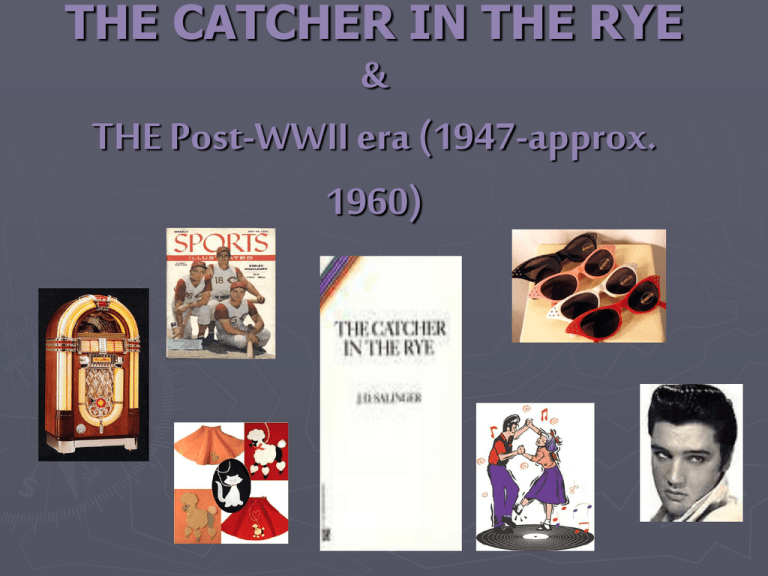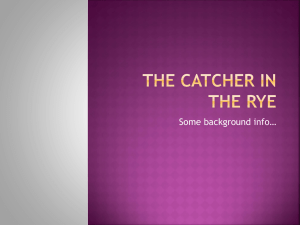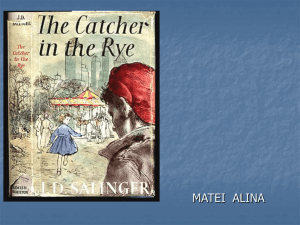THE CATCHER IN THE RYE & THE 1950's
advertisement

THE CATCHER IN THE RYE & THE Post-WWII era (1947-approx. 1960) THE CATCHER IN THE RYE • The time period after World War II was an era • of change, something the main character of the novel, Holden Caulfield, is not ready to accept. To be able to truly understand the world in which Holden lived, we must journey back in time to the decade of the 1950’s. A number of significant historical events relevant to all people took place in the 1950’s. Here are just a few. • • • • Opening of Disneyland Launching of Sputnik Cold War Rosa Parks refuses to give up her bus seat Civil Rights Movement Polio Vaccine is created by Dr. Jonas Salk Growing up prior to World War II, teenagers were expected to pursue very particular paths in life. Males were expected to join the military or go out and get a job in order to help bring in money for their family or to take care of their future family. Females were taught how to take care of the household and prepare themselves to be a dutiful wife and take care of children. Also, teens had very little economic freedom, independence, and input in decision making prior to WWII. Education was much less of a priority than it is today. If kids finished high school, college was a relatively rare option. •Getting a job and getting married straight out of high school was much more common. Teenage Life after WWII Many things contributed to a new lifestyle after WWII: 1. New cultural movements 2. New technologies 3. Better economy 4. Increased focus on education In the late 1940’s/early 50’s, there were two consumer products that helped to create our modern concept of the teenager: the television and the automobile! More accessible + more affordable Sense of freedom Images of “cool” Emergence of fast food Possibilities for drinking + sex Life in the 1950’s cont. ► For the first time, teenagers created trends: -high school dances (sock hops) -clothing trends (poodle skirts and such) -dance fads (the twist, etc.) -hairstyles Mainstream Culture -poodle skirts and sock hops -hanging out by the jukebox -being cool but also “fitting in” Counterculture -”greasers” -leather jackets -riding motorcycles -smoking/drinking • James Dean • Marilyn Monroe • Elvis Presley Political climate The Cold War Constant paranoia about another world war McCarthyism—fear of communism in the US (we will discuss this more next week in connection with The Crucible) This state of unrest and anxiety can be reflected in psychological problems of people like the main character of Catcher in the Rye, Holden. J.D. Salinger was born in New York City in 1919. Was upper middle class and attended private schools. Excelled on the fencing team in high school, but flunked out of academics. Enrolled in a military academy where he began writing stories. He created Holden as a persona. Was a notorious recluse later in life and was resistant to having his book adapted into a movie. Died in 2010. Holden Caulfield, the narrator of The Catcher in the Rye, begins the novel with an authoritative statement that he does NOT intend for the novel to serve as his life story. Currently in psychiatric care, this teenager recalls what happened to him for four days last Christmas, which forms the basis of the novel. The beginning of the novel takes place at Pencey Prep School in Pennsylvania. Holden leaves Pencey and goes to various places in New York City, where he is from. The Genre - Bildungsroman German word for a “coming of age” novel. Coming of age novel = story of a sensitive person growing up who is looking for answers and experience. The goal for the character is maturity, which is not reached easily. This type of novel often features a struggle between the character and society. Immaturity Responsibility Values Conformity vs. individuality Grief Alienation/Self-Protection Loss of innocence Phoniness “FUN” FACTS Several shootings have been associated with the novel, most famously John Hinckley, Jr.'s assassination attempt on Ronald Reagan and Mark David Chapman's shooting of John Lennon. After the shooting, Chapman was arrested with his worn personal copy of the book, inside which he had scribbled, "Dear Holden Caulfield, From Holden Caulfield, This is my statement.” Catcher in the Rye, at different times, has been on the “banned books” list and was not allowed to be taught in schools due to graphic language and sexual references. However, to many, Catcher is considered one of the three “perfect American books” along with The Great Gatsby and The Adventures of Huckleberry Finn.









